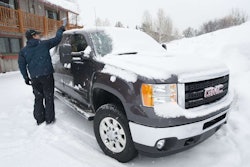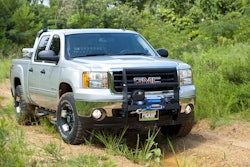On the Level
An air suspension or a set of helper springs can make hauling heavy cargo easier, but it won’t allow your truck to carry more.
By Peter D. DuPre (Photos courtesy of the manufacturers)
Most HD pickup operators occasionally have to use the bed to carry heavy loads of gravel, lumber, pipe, fuel drums, welding equipment, equipment parts, and other items from time to time.
 Or, they may have a service body that, when loaded down, pushes the truck’s max cargo capacity limits.
Or, they may have a service body that, when loaded down, pushes the truck’s max cargo capacity limits.
When those situations arise, many construction workers and contractors are surprised that their 1-ton just doesn’t seem up to the job; it sits low in the rear, wallows in turns, and feels light on the steering.
 The Hellwig helper leaf attaches to the top of the leaf spring and is held in place with a center bolt and shackles at either end. As the spring deflects the helper leaf, takes on the added load.
The Hellwig helper leaf attaches to the top of the leaf spring and is held in place with a center bolt and shackles at either end. As the spring deflects the helper leaf, takes on the added load.
No worries. I’ll just put on a set of helper springs to increase my truck’s hauling capability and everything will be fine, is what comes to most pickup owners’ minds.
Such was the situation in which my neighbor, Bill Turo, found himself. Turo runs a landscaping business in western Washington, operating a small three-truck fleet.
Usually, extra-heavy loads aren’t much of a problem for him, as he mainly carries mulch and landscape bark in the cargo box, towing a trailer to carry the usual tools and equipment of his trade.
Recently, however, he has bid on a couple of jobs that require hauling gravel – not so much that a dump truck delivery is needed, but just enough so that his three trucks are often fully laden.
 Scan this tag to learn more about vehicle weight ratings.
Scan this tag to learn more about vehicle weight ratings.
“These gravel loads are killing me,” remarks Turo. “My trucks sag at the rear, the tires rub on the inner fenders and don’t seem to be able to handle the extra weight. I am thinking of modifying my trucks to increase the gross vehicle weight rating (GVWR), so I can carry more weight and stopped by to ask your opinion.”
I explain to him that GVWR is set by the manufacturer and cannot be changed by anyone else.
“Your ’05 F-250s are rated to carry 3,000 pounds of payload. A yard of 2-inch-minus gravel weighs about 2,800 pounds,” I say.
“So you are at max payload capacity. What you need is an air-spring suspension or a set of helper springs installed to level the load.”
“Isn’t that the same thing as increasing the payload capacity,” he asks?
“No, it isn’t.”
COMMON MISCONCEPTION
According to Bruce Beck, marketing manager of PacBrake, a Vancouver, BC, company (www.pacbrake.com) that manufactures air brake and air-suspension systems worldwide, it is a common misconception that adding a load-leveling suspension increases a vehicle’s carrying capacity (GVWR).
 A PacBrake air tank can store enough air to keep the suspension level and supply enough pressure to operate an air wrench.
A PacBrake air tank can store enough air to keep the suspension level and supply enough pressure to operate an air wrench.
“People put in air bags and think it increases load-carrying ability,” says Beck, but it’s the vehicle manufacturer that determines that based on the axles, brakes, engine, and other components. Once that truck leaves the factory, its GVWR can never be changed.
“Although adding an air-bag or air-spring suspension won’t legally (liability) allow your truck to carry more weight,” continues Beck, “installing one will level out your vehicle, so that it handles more like it does with a lighter load.”
UNDERSTANDING AIR SUSPENSIONS
So what exactly is an air helper spring or an air suspension? Simply put, a heavy-duty rubber “bag” that is inflated to maintain a desired ride height.
 R4Tech’s air-suspension kit uses a helper leaf that runs under the spring to a mounting bracket on the underside of the axle – a difference from all other systems offered.
R4Tech’s air-suspension kit uses a helper leaf that runs under the spring to a mounting bracket on the underside of the axle – a difference from all other systems offered.
The bag is constructed of a multi-layered material similar to that of a tire sidewall and usually has steel cable rings around the outside, for added strength and stability, giving it a coil spring-like appearance.
Many air spring suspension systems are installed in place of the factory jounce stopper that protects the suspension from bottoming on the vehicle’s frame.
 Close up of the end of the SuperSprings helper leaf shows how roller shackle works, continually adjusting to spring movement to always find the most neutral position.
Close up of the end of the SuperSprings helper leaf shows how roller shackle works, continually adjusting to spring movement to always find the most neutral position.
Returning the truck back to its level factory ride height changes the weight balance fore/aft. That, in turn, helps lessen other handling issues such as wallowing in the turns, light front end steering, bottoming out of suspension, rubbing tires and rear sway.
Another benefit of an air helper or air suspension is many of the air springs are individually controlled, so it’s easy to make side-to-side and front-to-rear height adjustments, where an absolutely level ride can be achieved, eliminating the feeling of instability.
The basic helper air-spring kits are typically easy to install and relatively inexpensive. The more sophisticated the air suspension systems, which may or may not replace the factory springs front and rear, the more installation time and cost.
But they all make a big difference in how your pickup “handles” those heavy loads in the bed.
>
Augmenting the Air Springs
Although a set of rear air springs can restore your loaded-down pickup’s stock ride height, it sometimes needs a little extra help to restore the handling to OE specs, and that’s where helper springs and anti-sway bars enter the picture.
A helper spring is an additional progressive-rate spring-leaf that attaches to the top of the leaf springs, and can help increase a vehicle’s carrying capacity (but not increase GVWR).
Although helper springs and air springs are often used independently of each other, they are often used in combination: The helper springs help shoulder the load while the air springs raise ride height.
Another aid to maximizing pickup control while hauling heavy loads is the addition of – or upgrade to – the anti-sway bar.
Companies that specialize in suspension and load control, such as Hellwig, have anti-sway bars that replace or upgrade the OE offering. They make a big difference in pickup handling – loaded or empty. – PD
AIR-SUSPENSION PRODUCT SHOWCASE
 Firestone Ride-Rite
Firestone Ride-Rite
Available for virtually all 2WD and 4WD pickups, Firestone’s Ride-Rite air-spring kits help maintain vehicle stability, ride quality, brake effectiveness, and reduced tire wear. The system features individual inflation valves to allow for separate side-to-side or front-to-rear adjustment, which helps keep the vehicle level when carrying off-center loads, maintaining ride quality under differing load conditions. Two-year warranty. Remote dash-control also available.
Firestone Industrial Products;
ride-rite.com; 800-247-4337
 Hellwig Products
Hellwig Products
Hellwig has been manufacturing helper springs since the mid-1960s and a few years ago added air-suspension kits that increase stability and control, reduce bottoming, and provide the ability to level the heaviest loads from left to right and front to rear. Available standard with  manual fill using a remote air supply or with optional in-cab controls or automatic load leveling via an onboard compressor. Hellwig also manufactures heavy-duty anti-sway bars for tock and lifted pickups.
manual fill using a remote air supply or with optional in-cab controls or automatic load leveling via an onboard compressor. Hellwig also manufactures heavy-duty anti-sway bars for tock and lifted pickups.
Hellwig Products;
800-435-5944
 PacBrake
PacBrake
This Canadian manufacturer, known for its diesel exhaust brakes, has been making heavy-duty products for OEMs and the aftermarket for more than 50 years. PacBrake also builds air suspension systems with a limited-lifetime warranty. According to the company, PacBrake’s air springs are the only ones on the market with 1-inch CNC-machined aluminum end caps and 18 support wires for maximum strength and durability. Kits are available for all pickups and have optional on-board air tank and compressor that can power air wrenches.
PacBrake; pacbrake.com; 800-663-0096
 R4Tech
R4Tech
SanLuis Rassini, the parent company of R4Tech, is the world’s largest designer and manufacturer of leaf springs for light vehicles. The company’s air-bag suspension system is designed specifically for each vehicle and uses a combination of leaf spring, Firestone air bag, and dash-controlled air compression to maintain level vehicle ride height. The R4Tech system is automatically self-leveling, adjusting itself to the desired ride height as cargo weight and tongue weight change. The R4Tech Suspension is available for commercial vehicles, chassis cabs, cut-away vans, as well as all heavy-duty pickup applications.
R4Tech; R4Tech.com; 734-454-4904
 SuperSprings
SuperSprings
SuperSpring’s installation of its “airless” airbag SumoSprings is “fit it and forget it.” These high-grade, closed-cell polyurethane foam air bags can be compressed to up to 80 percent of original the size (depending upon front/rear installation). SumoSprings are designed to work well in confined spaces and have  high resistance to abrasion, UV, and oils. SuperSprings’ overload helper spring features a height-adjustable roller shackle that allows it to always adjust precisely to the load put on them.
high resistance to abrasion, UV, and oils. SuperSprings’ overload helper spring features a height-adjustable roller shackle that allows it to always adjust precisely to the load put on them.
SuperSprings; supersprings.com;
800-898-0705








